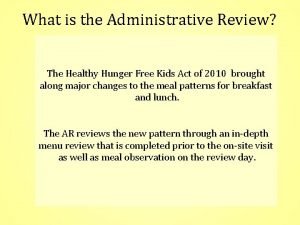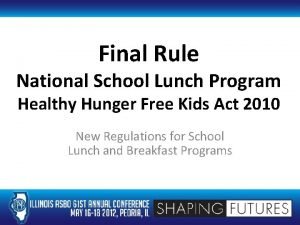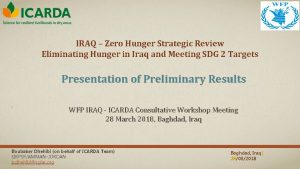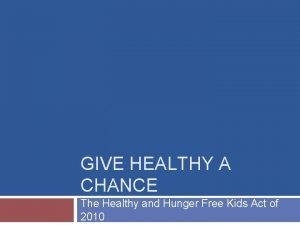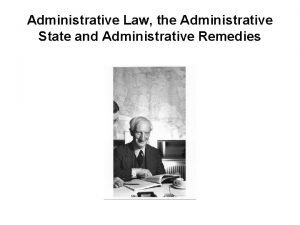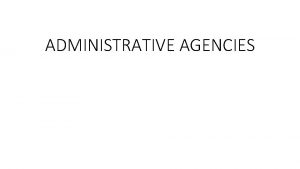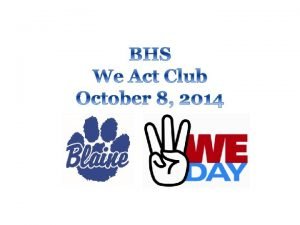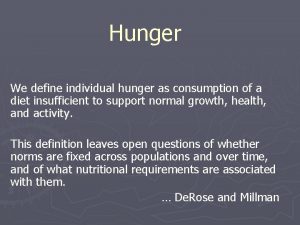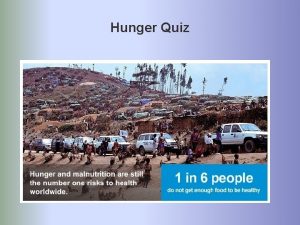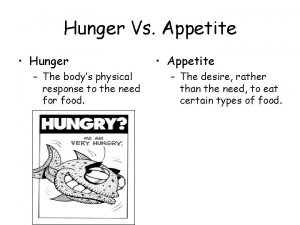What is the Administrative Review The Healthy Hunger
































- Slides: 32

What is the Administrative Review? The Healthy Hunger Free Kids Act of 2010 brought along major changes to the meal patterns for breakfast and lunch. The AR reviews the new pattern through an in-depth menu review that is completed prior to the on-site visit as well as meal observation on the review day.

Administrative Reviews will be completed on a 3 year cycle. This increases the state’s opportunity to visit schools and offer technical assistance. Having more frequent reviews will hopefully bring a decrease in review findings and create more effective child nutrition programs in the schools.

There are 4 main focus areas of the AR: Performance Standard 1: This focuses on meal eligibility and counting and claiming. Performance Standard 2: This standard focuses on the meal quality; menu components, serving sizes and nutritional quality. Resource Management Comprehensive Review: This is a part of the review that takes an in-depth look at the financial aspects of the program. General Areas: This includes, food safety, civil rights, wellness policy, etc.

Step 1: Notification of Review The state agency will send a notification to all of the SFAs that are selected for review in the SY. They will receive a letter letting them know that they will be contacted to schedule the review. Step 2: Scheduling the Review Determining the site(s) for review: • The number of sites selected for review is based on the number of participating schools within the SFA. • There are USDA criteria that is used when selecting the specific sites. • The length of the on-site review will be based on the number of sites that must be reviewed and the number of meal applications that will need to be reviewed.

Step 3: Pre-Review Procedures Selecting the site for a targeted menu review: • Meal compliance assessment procedures Additional Pre-review documents: • Off-Site Assessment • Dietary Specification Assessment Tool (targeted menu site only) • Menu Documentation Review

Off-Site Assessment When completing the Off-Site Assessment: • Work as a team • Answer the questions completely • Be as accurate as possible • Submit it by the due date • Submit all the requested supporting documents

Dietary Specification Assessment • Only needed for the site that is selected for the Targeted Menu Review. (the reviewer will let you know what site this is) • The reviewer will tell you if you need to complete breakfast and lunch or lunch only. • Read each statement carefully. • Answer each statement honestly.

Menu Documentation Review Week of Menu Review A single week from the review month will be selected for the menu documentation review. The reviewer will work with the SFA to determine the week. What Menus are Reviewed? All unique menus that will be observed at the review site(s) must be submitted for menu review. What Menu Documentation Needs to be Submitted? Production Records, Menus, Standardized Recipes, Labels, CN labels

Step 4: On-site Review SFA Level: • Applications • Verification • Claims • Resource Management* • Civil Rights • Wellness Policy • Food Safety Plan • Record Keeping • SBP and SFSP outreach • FSMC* Site Level: • Point of service • Meal components • OVS • Kitchen walk through • Civil rights • On-site monitoring • Competitive Foods • Water • Food safety • Record Keeping

Certification and Benefit Issuance Eligibility Benefit Issuance list from Eligible all. Documentation sites Students participating within the SFA Categorically MUST: Students Extended Eligibility through theinclude: Direct Certification Income. Foster Applications Students MUST: • • Supplemental Total number of eligible students in the SFA Report Nutrition Assistance Program (SNAP) orreviewed. Temporary Reviewer will determine which. MUST: applications will be • • Assistance Identify students were selected for Verification Names ofwhich all forhousehold Families (TANF) members or Food Distribution Program ü Be on an approved complete list (Homeless, Migrant, Applications will beand reviewed district wide, not just selected on ü Have Indian an approved Reservations application (FDPIR) file OR MUST include: Head Start) sites. • Runaway, List must come from the point on of. Applications service ü Be documented the Direct Certification Report or on a household income and frequency • All A of on denied applications will also be reviewed. Nopercentage duplicatesmember’s separate üCase Have approved from the County indicating their Be on. Number thedocument. Direct documentation Certification Report • üIndication List of students eligible for free and reduced meals (do not foster status of no income for those that have none SFA must provide: include paid students). For each student the list must provide: üSignature The documentation must include the date they were added, and of adult household member • Certification Document (application, direct certification, • student’s name, the student they reside with that is listed on the Direct üSignature of that adult household member eligibility list) • school. Report. name, Certification • Verification documents (if applicable) üLast 4 • digits ofstatus, Social Security Number benefit • Notification of benefits • method of certification, • Any follow-up and/or with ü*Must be approveddocumentation using the correct USDAcommunications Income Eligibility • date of certification the household Guidelines

Verification All Verified applications will be reviewed • • Initial application Notifications sent to households Verification documents submitted by households Notification of results of Verification • Reviewer will complete a detailed review of 10% of verified applications • Summary of Verification Efforts • This is the report that the SFA is required to maintain each year, but is NOT required to submit to the State.

Claim for Reimbursement and POS Claiming documents from all sites within the SFA will be reviewed • Review month claim from each site • Edit check from review month for each site • Consolidated claim for review month Point of Service (POS) Does the system avoid overt identification? Does it provide an accurate meal count? How are meals consolidated at the end of service? How does the POS ensure that students are not claimed more than once?

Meal Compliance Production Records: Are the records complete? Were all components served each day? Were the correct portions served for each component?

Meal Compliance Continued Meal Service Was each component available to all students? Were portion sizes accurate? Two varieties of milk Were reimbursable meals selected? Offer vs. serve implemented correctly (if applicable) Is there proper signage that identifies a reimbursable meal?

Meal Compliance Continued • • Production Record Requirements Food components Recipe or food product used Planned/projected number of portions and serving size for each age/grade group Planned/projected number of portions and serving size for adults Total amount of food prepared Actual number of servings for each item served Actual number of non-reimbursable meals served (adult or a la carte) Leftovers and substitutions

Meal Compliance Continued Meal Preparation Observation During meal preparation are: Standardized Recipes used? Are correct measuring tools used? Are proper food safety practices followed?

Resource Management Audits Non-Profit School Food Service Account Paid Lunch Equity Revenue from Non-Program Foods Indirect Costs USDA Foods Paid Lunch Equity Tool http: //www. fns. usda. gov/paid-lunch-equity-school-year-20142015 -calculations-and-tool Non-Program Foods Revenue Tool http: //www. fns. usda. gov/cnd/governance/policy 2006 -2011. htm

Civil Rights • The SFA's public release • Description of the SFA's procedures for receiving and handling a Civil Rights complaint • Information on the number and description of complaints alleging discrimination in the current and prior school year • Date, agenda and attendees of the recent Civil Rights training for the SFA staff • Need and availability of translation services • Description of the SFA's procedures for collecting racial/ethnic data • The non-discrimination statement used on all program materials • "And Justice For All" poster

On-Site Monitoring *Important: On-site monitoring is only required if the SFA has more than 1 building that participates in the NSLP and/or SBP. Documents to Review: Current year on-site review forms http: //www. fns. usda. gov/cnd/governance/Policy. Memos/2011/SP 14 -2011_os. pdf

Wellness Policy At a minimum the Wellness Policy must include: 1. Goals for Nutrition Education 2. Goals for Physical Activity 3. Goals for other school based activities to promote wellness 4. Nutritional guidelines for all food sold on campus 5. Goals for Nutrition Promotion *The wellness policy should be developed by a team that includes, teachers, food service staff, parents, administration and students NEW with Reauthorization: 1. SFAs are required to make the Wellness Policy public 2. SFAs must periodically measure the implementation of the policy 3. The SFA must designate one or more school officials to ensure compliance with the wellness policy

Competitive Foods & A la Carte 1. Ensure that there is no sale of competitive foods and that foods of minimal nutritional value are not available during meal service in the serving or dining area. 2. All food sales must be incompliance with the new guidance starting in the 2014 -2015 school year. 3. Have copies of the nutrition labels of all foods sold within the school during the school day available for review.

Water The Healthy Hunger Free Kids Act requires that potable water be made available to all program participants free of charge during both breakfast and lunch service. While observing breakfast and lunch you must ensure that free water is available for consumption by program participants. Schools can provide water in a variety of ways: • Water pitchers and cups on tables • A water fountain • Water dispenser with cups in the cafeteria

Food Safety Inspections • Copy of the most recent food safety inspection must be posted at each site in a prominent location • The SFA needs to provide documentation of the two most recent inspections Temperature Logs • For the cooler(s), Freezer(s) and Store room • For all food that required cooking to an established internal temperature • For food that needs to be maintained below 41 Food Safety Plan Copy should have already been submitted with off-site assessment, but each site should have a copy maintained on site.

Record Keeping As you review other areas, you should be evaluating that the appropriate reporting and record keeping requirements are in compliance. Page 166 -167 of the Administrative Review manual list the common reports and records that the SFA must have on file.

Other Programs Afterschool Snack Program (ASSP): Ensure that production records are maintained and all snack items offered are creditable. Fresh Fruit and Vegetable Program (FFVP): Have documentation of products served and detailed claims for reimbursement. Special Milk Program (SMP): Pricing Policy, counting and claiming procedures, milk service procedures and records. Seamless Summer Option (SSO): Meal counting and claiming practices, menu planning, and meal service.

Step 5: Administrative Review Report The reviewer must provide the SFA with written notification of the review findings: • Superintendent or authorized representative • Commendations • Review findings • Corrective Action Plan • Potential for Fiscal Action • Right to an appeal

How can I have a Great Review? Team work: Get everyone involved Provide in house trainings Don’t leave it up to just one person Organization: Determine the best way to present all the requested materials Binders, folders, paperclips, hanging files, etc. Over prepare!! Double, triple check everything Read all of the guidance and resources that are available

This seems overwhelming… • Start early • Ask questions • Submit requested information by requested dates • Be responsive • Use your team to get prepared • Don’t wait until the morning of the review • Stay up-to-date on trainings

Use the Review tools • All of the administrative Review forms are on the USDA website • Do an in house review using the tools • Make sure you understand the questions and you are in compliance Administrative Review Tools: http: //www. fns. usda. gov/nslp/administrative-reviewmanual

Helpful Tips • Make sure you have signage so that students know what a meal consist of. • Educate your staff/ cashiers what a meal consist of • Make sure your staff knows about HACCP and where the manual is in each building • Make sure your HACCP manual is current. • Be able to show that you make the public aware of your summer programs and your breakfast program. This can be on your website and with flyers, and on your menus.

Helpful Hints continued • Local wellness policy is posted for public to see. • Make sure you have your Wellness Committee meeting minutes and attendees for review • Have a policy manual of department policies and procedures for review. • Standardized recipes are being used • Students has access to potable water • For your ala carte items go to address below • https: //www. healthiergeneration. org/tak e_action/schools/snacks_and_beverages/smart_ snacks/alliance_product_calculator/_

Helpful Hints continued • Make sure “and justice for all posters are visible • Health inspection report posted and visible • Proper Portion sizes are offered and meets component requirements • Edit check sheets are completed and accurate • On Site monitoring completed for each building within the SFA • All Snacks meet regulations- run through the smart snack calculator
 Healthy hunger calgary
Healthy hunger calgary Healthy hunger
Healthy hunger Healthy forests healthy communities poster contest
Healthy forests healthy communities poster contest Healthy nurse healthy nation
Healthy nurse healthy nation Journal on healthy food healthy mind
Journal on healthy food healthy mind Healthy soil healthy life poster ideas
Healthy soil healthy life poster ideas Chapter 9 making healthy food choices
Chapter 9 making healthy food choices Narrative review vs systematic review
Narrative review vs systematic review Ap gov review final exam review
Ap gov review final exam review Narrative review vs systematic review
Narrative review vs systematic review What is inclusion and exclusion
What is inclusion and exclusion Chapter review motion part a vocabulary review answer key
Chapter review motion part a vocabulary review answer key Các môn thể thao bắt đầu bằng tiếng chạy
Các môn thể thao bắt đầu bằng tiếng chạy Khi nào hổ con có thể sống độc lập
Khi nào hổ con có thể sống độc lập điện thế nghỉ
điện thế nghỉ Biện pháp chống mỏi cơ
Biện pháp chống mỏi cơ Trời xanh đây là của chúng ta thể thơ
Trời xanh đây là của chúng ta thể thơ Gấu đi như thế nào
Gấu đi như thế nào Số nguyên tố là gì
Số nguyên tố là gì Thiếu nhi thế giới liên hoan
Thiếu nhi thế giới liên hoan Vẽ hình chiếu vuông góc của vật thể sau
Vẽ hình chiếu vuông góc của vật thể sau Một số thể thơ truyền thống
Một số thể thơ truyền thống Các châu lục và đại dương trên thế giới
Các châu lục và đại dương trên thế giới Thế nào là hệ số cao nhất
Thế nào là hệ số cao nhất Hệ hô hấp
Hệ hô hấp Tư thế ngồi viết
Tư thế ngồi viết Hình ảnh bộ gõ cơ thể búng tay
Hình ảnh bộ gõ cơ thể búng tay đặc điểm cơ thể của người tối cổ
đặc điểm cơ thể của người tối cổ Mật thư anh em như thể tay chân
Mật thư anh em như thể tay chân Tư thế worms-breton
Tư thế worms-breton ưu thế lai là gì
ưu thế lai là gì Thẻ vin
Thẻ vin Cái miệng bé xinh thế chỉ nói điều hay thôi
Cái miệng bé xinh thế chỉ nói điều hay thôi
